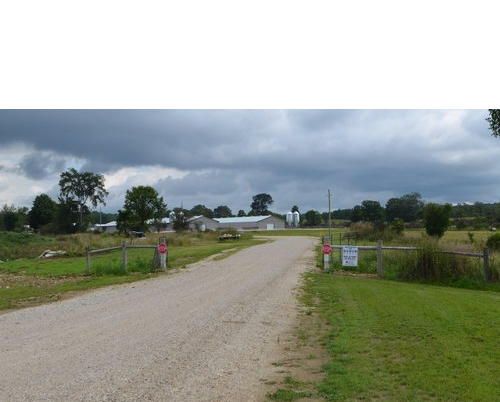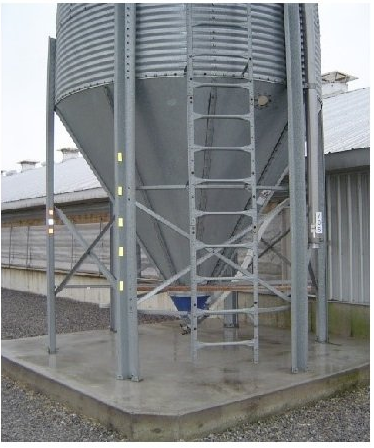Managing external risks
Controlling the spread of pathogens outside the barns is your first line of defence in biosecurity. This includes visitor and traffic protocol as well as control of insects, rodents, and wild birds.
Managing Farm Traffic & Visitor Protocol
To reduce potential introduction and spread of pathogens by traffic entering and leaving the farm, follow these basic guidelines.
- Vehicles and farm equipment coming onto the farm site can be controlled using farm gates at the entry lane. The farm entry gate should be lockable and kept closed and locked when no one is on the farm
- Vehicles and equipment coming onto the farm site must be clean and free of organic material
- Farm equipment must be cleaned prior to going from one barn to another of different aged or species of livestock or poultry
- We recommend the use of a Visitor Log that visitors must sign before being allowed entry to the farm
- Visitors must be accompanied by farm staff when entering the farm site, and must be by appointment only
- Visitors must follow the farm’s stated biosecurity program including use of biosecurity clothing, boot covers, and hand sanitization

Insect control
Flies and darkling beetles are potential disease spreading vectors. The emergence of insects are the symptom of a larger problem. Many want to treat for adult insects with insecticide, but this does not manage the source of the problem, which is usually traced back to litter management.
Potential causes of insect development:
- poor water drainage on the farm site
- poor air circulation between barns and in barns
- infrequent manure removal
- excess water leakage from drinkers
- excess feed wastage
- inadequate manure storage facilities
Step One - Short term management changes
- Keep the drinker system well maintained (fix leaky fittings). This prevents excess water from accumulating in the pen bedding or litter, under the barns and in manure collection areas
- Decrease the practice of flushing drinker water or dumping drinker water during drinker cleaning onto the bedding or leaving in the barn
- Keep feed contained in a feed pan, bin or area to minimize spillage
- Create air-circulation in barns and sheds using fans, etc. to move air to keep bedding/litter and floors dry
- Keep vegetation between barns & sheds mowed. This minimizes shelter areas for flies and allows for adequate air circulation
Step Two - Long term management changes:
- Develop adequate drainage around barns
- Use proper grading to allow water to run away from the farm site. This system would be set up to optimize microbial breakdown of the waste water
- Develop an efficient manure and mortality removal process with removal on a regular basis.
- Develop a composting facility to process manure, mortality and other organic waste. Composting material must be kept covered
- Enclosed barns or sheds allow for better fly control with a controlled environment and increased biosecurity
- Livestock/poultry facilities should have cement floors for ease of cleanup and sanitation
- Between flocks, a beetle control program can help with flies.
In acute situations, pesticides can be used in conjunction with manure removal. Always follow local regulations and follow each pesticide product label carefully.
Rodent Control
Rodents are persistent creatures that can cause havoc on your farm. They are able to squeeze through openings as small as half an inch, they can memorize routes, and tend to avoid new objects (such as traps). Because of their continuously growing incisors, their drive to chew anything and everything leads to significant damage. They also consume expensive feed and can easily act as a vector for diseases such as avian influenza. Consider consulting a professional pest control company if you need extra assistance.

Step One
- Eliminate the reasons (feed, water, nesting sites) why rodents want to infest your farm.
- Remove the welcome mat. Clean up feed spillage from bins quickly. Eliminate all outside debris such as old equipment, boards, pipes etc., that rodents can use for hiding or nesting. Eliminate weeds to provide a 3 foot (1 m) clean perimeter around each building.
Step Two
- Stop rodents from gaining access to your buildings.
- Good building construction is a must. Mice can enter through a hole the size of a dime (18mm) and rats through a quarter-sized (24mm) hole. It is important to specifically audit your facilities looking for evidence of rodent activity and for areas where they might be entering. If you don’t look, you won’t find. A common entry point for mice is the unprotected end of corrugated metal siding on buildings. Doors must fit snugly or have anti-pest tension strips or door sweeps installed. Close openings around augers, pipes and wires with cement mortar, masonry or metal collars.
Step Three
- Reduce the rodent population by trapping or providing poison baits.
- This involves proper selection and location of bait stations and bait. There are many different types and forms of baits available. Single dose poisons are preferable. The best one to use is the one preferred by the rodents on your farm. To determine this, choose an area of high rodent activity and leave a variety of types of baits on a piece of cardboard in a sheltered area (ie: behind a piece of wood leaning against a wall).
- In a few days check to see which bait(s) your rodents prefer and use those ones to bait the entire farm. Certain forms such as wax blocks are useful in damp or in hard-to-reach areas such as attics. Do not store baits with other chemicals or handle with bare hands, as the bait may absorb odours, which will reduce the bait’s effectiveness.
- Carefully read and follow label directions on all rodenticides which are poisonous, and handle them accordingly.
- Placing of stations should vary with the condition of the barn and levels of rodent activity. 50-75’ (15.24 -22.86 m) and by the entryway is a good range. Pictured is a good example of bait station placement. The station is right beside the barn wall and free from any weeds or grass. Stations should be inspected monthly, although the frequency varies on rodent pressure and surroundings. Inside the barns, consider placing mechanical traps in the entryway and attic as well as storage, and maintenance rooms.
Wild Bird Control
There are various species of birds that are prevalent in and around most farm sites. Birds are natural carriers of disease and parasites. They naturally seek shelter and food. Farm buildings are attractive to them for this reason.
Step One - Eliminate access to shelter
- Keep barn doors closed, and if open in warm weather, screen entry (¼ in. mesh)
- Open sided barns or windows must be screened
- Openings under eaves for air entry for poultry in livestock barns must be screened
- Keep barn in good repair inside and out so there are no openings for birds to enter
Step Two - Eliminate access to food
- Manure should only be stored on a short-term basis. This waste is then removed off the farm site
- All used poultry litter should be stored (and covered) in accordance with farm conservation and nutrient management practices. It should be a minimum 100’ (30 m) away from turkey barns. It is more beneficial to remove it from the farm completely.
- Mortalities are to be stored in sealable containers until removed from the farm site
- Compost and garbage containers are to be located away from the barns and covered
- Clean up any spills immediately (manure or feed)
- Feed storage must be in bird proof feed bins

